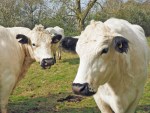Tree Creeper
26th Apr 2017 by admin
We have a new record, for the Reserve, of a tree creeper — photos and sighting by recording co-ordinator Rose Battye.

⚘⚘⚘
Water Fleas
23rd Apr 2017 by admin
Adrian Chalkley, Suffolk County Recorder writes,

⚘⚘⚘⚘⚘⚘⚘⚘⚘⚘⚘⚘⚘⚘⚘⚘⚘⚘⚘⚘⚘⚘⚘⚘⚘⚘⚘⚘⚘⚘⚘⚘⚘⚘⚘⚘⚘⚘⚘⚘⚘⚘⚘⚘⚘⚘
Cattle at the reserve
12th Apr 2017 by admin
Rare Breed English White Cattle
Cattle grazing 2016-17 for traditional Suffolk meadowland enhancement at Simpson’s Fromus Reserve
The Trust’s objective at Simpson’s Fromus Reserve is to enhance the floral richness of these ancient meadows. Since February 2008, the Reserve has been entered in organic environmental stewardship. The first rule of management, of course, is no artificial fertilizers or herbicides. The second is to keep the sward-height low, to allow sunlight and rain to penetrate to the broadleaf flowering plants that we wish to encourage. The specified targets are 5-15 cm height in April to May, unless the field is conserved for hay or silage, and the same at the end of the growing season in November.
In past years, the whole Reserve has been closed in Spring for hay or silage, which has been harvested after 30th June, and the aftermath growth reduced by grazing. From 2013 until 2015, local farmers have taken the grass harvest and brought in their cattle for the autumn months — but things change, and in 2016 we could find no local cattle-owners who wanted the grass-harvest or grazing, nor a market for our organic hay. As a trial, we decided to change to an all-grazing system and brought in the Trust’s small herd of six British White cows and heifers, previously housed at Sinfield Nature Conservation Trust’s White House Farm, Hasketon. The Soil Association rules (for organic status) allow unlimited grazing by this rare breed.
Looked after by local farmer Philip Baskett, and registered with a local veterinarian, these beautiful animals have done a good job in bringing down the tall grass. The reserve was already divided into three grazing units, around which the cattle have been rotated.
There have been other consequences. Over the wetter winter months, gateways have become muddy passages, and hoof-prints have indented the soil. While challenging, in places, for the human walker, the effect will provide diversity in the habitat for small plants and invertebrate animals, and may bring to life long-dormant seeds of ancient meadow flora. Cattle dung will attract coprophagous creatures, and increase habitat diversity for plants and fungi.
Guardians and other visitors will find these cattle docile and friendly. There are three grazing compartments, and you can check beforehand where they will be. If you ignore them, they will ignore you. If you want a nosey cuddle, please bring carrots or apples, and you’ll have friends for life! You can always push them gently out of the way if they are too intrusive and, once they appreciate you have no more eatables, they will lose interest.
We shall assess the results carefully during the Summer of 2017, and apply our observations to conservation planning for next year. Meanwhile, two cows and three heifers have been served by artificial insemination, so we hope for autumn calves …
… and, finally, don't forget to watch Cow – the moo-vie!
⚘⚘⚘⚘⚘⚘⚘⚘⚘⚘⚘⚘⚘⚘⚘⚘⚘⚘⚘⚘⚘⚘⚘⚘⚘⚘⚘⚘⚘⚘⚘⚘⚘⚘⚘⚘⚘⚘⚘⚘⚘⚘⚘⚘⚘⚘
Open day at Fromus Valley, 1st April
9th Apr 2017 by admin


⚘⚘⚘⚘⚘⚘⚘⚘⚘⚘⚘⚘⚘⚘⚘⚘⚘⚘⚘⚘⚘⚘⚘⚘⚘⚘⚘⚘⚘⚘⚘⚘⚘⚘⚘⚘⚘⚘⚘⚘⚘⚘⚘⚘⚘⚘
"Pond dipping as art" — but is it art?
4th Apr 2017 by admin
Watch the video here!
⚘⚘⚘⚘⚘⚘⚘⚘⚘⚘⚘⚘⚘⚘⚘⚘⚘⚘⚘⚘⚘⚘⚘⚘⚘⚘⚘⚘⚘⚘⚘⚘⚘⚘⚘⚘⚘⚘⚘⚘⚘⚘⚘⚘⚘⚘
Aquatic environmental essay inspiration
3rd Apr 2017 by admin
Pond Dipping
At our Open Day on 1st April, we were thinking about the aquatic environment. We are not only hoping to inspire poets to enter our poetry competition, but also budding environmentalists at school to enter our essay competition. With that in mind, Adrian Chalkley – the Suffolk County Recorder of Freshwater Invertebrates – was pond-dipping at the long and round ponds, and he found some lovely beasties!
There were dragonfly larvae, innumerable water fleas and a water snail, may-fly larvae and some interesting partially parasitic mites. They lay their eggs on the back of another larva that will eventually fly – and when they do, the mite eggs get transported to drop off into a new place.
The interesting Victorian back-story of the caddis fly larva had us intrigued. The caddis-fly larva has a sticky glue secreting gland under its “chin”. It picks up small bits of bark and other plant material which it sticks together — as in the row of pictures below — to form a protective tube. Victorian gentleman-scientists would add tiny gemstones to a tank containing caddis-fly larvae, which would pick up the stones to make their little tube in the absence of any other material. Victorian ladies would then kill the caddis fly using alcohol, and turn the gemstone-tube into jewellery.
⚘⚘⚘⚘⚘⚘⚘⚘⚘⚘⚘⚘⚘⚘⚘⚘⚘⚘⚘⚘⚘⚘⚘⚘⚘⚘⚘⚘⚘⚘⚘⚘⚘⚘⚘⚘⚘⚘⚘⚘⚘⚘⚘⚘⚘⚘
Poetry Inspiration of the Fromus — video
2nd Apr 2017 by admin
If you were able to visit our Fromus Valley reserve yesterday, hopefully you will have been inspired by the tranquil beauty of the place, alive with spring birdsong and primroses. If you weren’t able to make it, watch this little video of the Fromus in full flow, flowing gently downstream.
